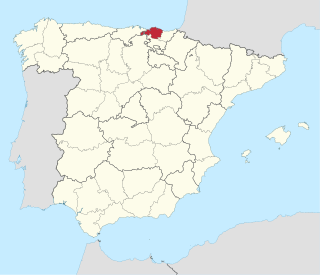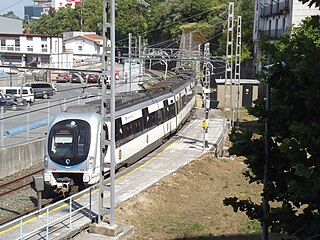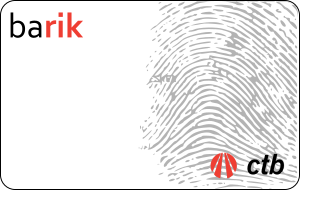
Creditrans was a travel card used to travel around Biscay, in the Basque Country (Spain). The card was the most popular ticket in the area, used by over 100 million passengers in 2007.

Creditrans was a travel card used to travel around Biscay, in the Basque Country (Spain). The card was the most popular ticket in the area, used by over 100 million passengers in 2007.
When the Metro Bilbao system was created in 1995 the local authorities realized that the transport system integration around Bilbao was very deficient. There were four rail companies (five after the opening of the tramway) and two bus companies, each one with different zones and fare systems, plus different ticket machines and even ticket sizes.
The Biscay Transport Consortium (CTB), created in 1975 to build the underground, was the public company that would lead the efforts to overcome the situation.
After some efforts to adapt the machines and information systems, the bus and underground were integrated, the basque railways soon followed and finally FEVE entered the system in 2006.
The last remaining company to join the system was RENFE, which operates three rail lines in the area, the company was incorporated to the Creditrans system during 2009.
In 2012 the Creditrans tickets were replaced by plastic Barik card [1] which work on the same principle except you can add credit to them through the regular ticket machines instead of buying a new card each time.

The card worked as a cash card of 5, 10 and 15 € value. It could be acquired at the underground vending machines, tramway vending machines, tobacconists and ATMs.
When a Creditrans is validated, the amount subtracted from its denomination is variable depending on the transport used. Also, when using two transports in a row (for instance Underground and bus) a 20% discount is applied on the second trip.

Biscay is a province of Spain and a historical territory of the Basque Country, heir of the ancient Lordship of Biscay, lying on the south shore of the eponymous bay. The capital and largest city is Bilbao.

Renfe Cercanías AM, formerly known as Renfe Feve, is a division of state-owned Spanish railway company Renfe Operadora. It operates most of Spain's 1,250 km (777 mi) of metre-gauge railway. This division of Renfe was previously a stand-alone company named FEVE. On 31 December 2012, the Spanish government simplified the organization of state-owned railway companies by merging FEVE into Renfe and Adif. The rolling stock and the brand FEVE were transferred to Renfe, while the infrastructure was transferred to Adif.

Rail transport in Spain operates on four rail gauges and services are operated by a variety of private and public operators. The total route length in 2012 was 16,026 km.

Euskotren Trena, formerly known just as Euskotren is a commuter, inter-city and urban transit train-operating company that operates local and inter-city passenger services in the provinces of Biscay and Gipuzkoa, in the Basque Country, Spain. It is one of the four commercial brands under which Euskotren operates, as a public company managed by the Basque government. The entire 181.1-kilometre (112.5 mi) network uses 1,000 mm narrow gauge rail tracks which have been owned by the Basque Government since their transferral from the Spanish government; the rail tracks and stations were part of the FEVE network until its transferral. Euskotren Trena also operates the Donostia/San Sebastián metro under the brand Metro Donostialdea.

Euskotren Tranbia is the brand under which the tramway networks in the cities of Vitoria-Gasteiz and Bilbao are run. The system in Bilbao started operations in 2002, and the one in Vitoria-Gasteiz in 2008. It is one of the four commercial divisions under which Euskotren operates. The infrastructure is owned by the public entity Euskal Trenbide Sarea and tracks use 1,000 mm narrow gauge.

The Bilbao metro is a rapid transit system serving the city of Bilbao and the region of Greater Bilbao. Lines 1 and 2 have a "Y" shape, as they transit both banks of the river Ibaizabal and then combine to form one line that ends in the south of Bilbao. Line 3 has a "V" shape connecting the municipality of Etxebarri with the Bilbao neighbourhood of Matiko; the apex of the "V" is Zazpikaleak/Casco Viejo station, where all three current lines meet. The metro is connected with the Bilbao tram, Bilboko Aldiriak, Euskotren Trena, Feve, Renfe long-distance trains, and Bilbao's bus station. All three lines use metre gauge.

Areeta is a neighbourhood of Getxo. It is an affluent residential area that was built over the sands of a beach where the Gobela Creek died into a diffuse delta at the mouth of the Estuary of Bilbao in the early 20th century.

Bilbobus is the name for metropolitan bus services in Bilbao.

BizkaiBus is the name for bus services serving the province of Biscay, Spain. It is named after the Basque name of the province, Bizkaia. The buses can be identified by their distinctive green livery.

The Abando Indalecio Prieto railway station, usually known simply as Bilbao-Abando and previously known as Estación del Norte is a terminal railway station in Bilbao, Basque Country (Spain). The name comes from Abando, the district in which the station is located, and Indalecio Prieto, who was Minister of Public Works during the Second Spanish Republic. The station serves as the terminus station for several long and medium distance services operated by Renfe as well as commuter rail services within the Bilbao metropolitan area operated by Cercanías. The station has direct access to Metro Bilbao and to the tram, as well as many local and regional bus lines. The railway station Bilbao-Concordia, operated by Renfe Feve is located in close proximity. After the construction of the high-speed line Basque Y is finished, Bilbao-Abando will serve as the western terminus, which will involve the creation of a completely new station replacing the current one.
Euskotren, formally known as Basque Railways, is a public railway company controlled by the Basque Government and officially established in 1982 to operate several 1,000 mm narrow gauge railways inside the autonomous community of the Basque Country, under the terms of the Statute of Autonomy of the Basque Country. Originally operating under the commercial brand ET/FV, it took control of the management and operations of the narrow gauge lines formerly operated by the railway company FEVE. The commercial brand eventually changed to Euskotren, as it remains today. Since 2006, the infrastructure on which the company runs its trains has been owned by Euskal Trenbide Sarea.

Bilbao-Atxuri is a former terminal railway station in Bilbao, Basque Country (Spain). It served as the terminus station for the commuter rail trains of Euskotren Trena lines to Durango, Bermeo, Eibar and Donostia for over one hundred years.

Zazpikaleak/Casco Viejo – Zazpikaleak and Casco Viejo – is a railway station in Bilbao, Basque Country, Spain. It is located in the historical neighborhood of Casco Viejo, in the district of Ibaiondo. It links the Bilbao metro rapid transit services with the Euskotren Trena commuter rail network. It is the main railway hub for trips between the metropolitan underground network and the railway services to Eibar, Gernika, Bermeo and San Sebastián as well as the Txorierri valley. The original metro station opened on 11 November 1995, and on 8 April 2017 in its current form.

In Spain there is an extensive 1,250 km (780 mi) system of 1,000 mmmetre gauge railways. The majority of these railways was historically operated by FEVE,. Created in 1965 FEVE started absorbing numerous private-owned narrow-gauge railways. From 1978 onwards, with the introduction of regionalisation devolution under the new Spanish constitution, FEVE began transferring responsibility for a number of its operations to the new regional governments. On 31 December 2012 the company disappeared due to the merger of the narrow-gauge network FEVE and the broad-gauge network RENFE.

The Spanish city of Bilbao contains a dense urban rail network served by multiple operators, track gauges and types. It is one of a very small number of cities that have both narrow and broad gauge railways without any standard gauge railways.

The Bilbao-Concordia railway station, also known as La Concordia Station, and formerly and colloquially known as Santander Station, is a terminal railway station in Bilbao, Basque Country (Spain). The station was opened in 1902 and currently serves as the terminus station for several narrow-gauge regional and metropolitan railway services operated by Renfe Feve, a division of the state-owned Spanish railway company Renfe. The Bilbao-Abando railway station, also operated by Renfe and that offers medium and long-distance services is located in close proximity.

Barik is rechargeable contactless smart card, electronic money used for public transport in Biscay (Spain).
Metro Bilbao is the company that runs lines 1 and 2 of the Bilbao metro. It is owned by the Biscay Transport Consortium, itself dependent on the Basque Government and the Foral Deputation of Biscay. The ownership of the metro infrastructure is shared by the Biscay Transport Consortium and Euskal Trenbide Sarea.
Euskotren is a public railway operator in the Basque Country, Spain. Its rolling stock is formed by electrical multiple units used for Euskotren Trena commuter rail services, trams running on the Bilbao and Vitoria-Gasteiz tramway networks, and locomotives for hauling freight trains.
Ferrocarriles y Transportes Suburbanos, commonly known by its acronym FTS, was a railway company in the Basque Country, Spain. Founded in 1947 as the merger of various railway companies, it operated several suburban rail lines in the Greater Bilbao area. FEVE took over its operations in 1972, which in 1982 were transferred to the new company Basque Railways.